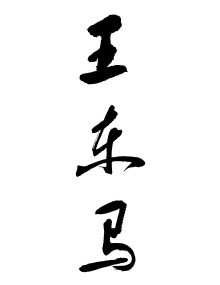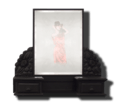Wang Dongma
| Wang Dongma | |
|---|---|
 Wang Dongma | |
| Born |
Wang Dongma July 9, 1980 Beijing |
| Nationality |
|
| Education | Zhejiang University (zh-tw: 浙江大學) |
| Known for | Electronic Art, Digital Art, New Media Art, Photography, Video Art, Carpentry |
Wang Dongma (Chinese: 王东马; pinyin: Wáng dōng mǎ) Mandarin: [wǎŋ dʊ̃ mà] is a Shanghai-based multimedia artist originally from Beijing, known for exploring a wide range of new media art forms since 2005. These include interactive mirrors, LED screens, electronic sculptures and large scale as well as miniature video installations that have been exhibited around China.[1] He is a main pillar of the island6 Arts Center and its in-house art collective Liu Dao, an artist run, not-for-profit group of artists, photographers, graphic designers, filmmakers, dancers, choreographers and electronic engineers.[2][3]
Background
Wang graduated from Zhejiang University with a BA degree in Physical Engineering in 1991. He gained his extensive knowledge and training in the engineering fields of optics and nanotechnology to create works that meld natural materials with an electronic, high-tech twist.[4] These pieces have been a central component of island6 works and exhibitions since December 2007, when he brought his skills to the island6 Arts Center as a resident artist, beginning collaboration with Liu Dao.[5]
Liu Dao
Wang’s life as academic and artist has enabled him to foster communication and dialogue with technicians and artists from different backgrounds in Liu Dao, such as Cai Duobao, Zhang Deli, Rose Tang, Bing Bing, Kong Mosha and Matt Carols.[6] Together, Liu Dao and Wang Dongma research technology as a visualization instrument, where Wang utilizes time-lapsed video and aerial photography as an apparatus for research in his study of visual landscapes.[7]
Wang’s artistic direction and Liu Dao’s physical construction and input results in a unique series of interactive mirrors that combine photography, fine arts, video, graphic art, illustration and drama with old school low-resolution technology.[8][9] This creates a striking contrast between traditional media and the natural materials used, and digital technology and electronic equipment.[10] Made of infrared sensors, two-way mirrors and video screens, the retro aesthetic of the works juxtaposed with their high tech content create a complex and beautiful sensory environment.[11] Through his technique, Wang constantly pushes through the borders of electronic and interactive art.[12]
Themes
Urbanization
The antique mirrors used by Wang are of Old Shanghai furniture from the shikumen longtang and yangfang longtang periods, which together made up a century of Shanghai housing from the mid-19th Century to the mid-20th.[13] The shikumen, or “stone gate” style of housing is found only in Shanghai. It is a blend of Eastern and Western architectural styles built in the foreigner concessions, but the conceptual and aesthetic beauty of these structures has not withstood the test of time[14] Wang’s mirrors speak through their images of the stone archways and brick alleyways disappearing day by day to be replaced by large, charmless, modern apartment blocks as the architecture of Shanghai’s past is being swept away by urban momentum,[15] and this sense of passing permeates Wang’s productions.
Globalization
Wang and Liu Dao’s project continually entices visitors into the increasingly prevalent contemplations of China and Shanghai’s cherished traditions in the face of its high tech infrastructural developments and the tides of technological upgrades rapidly sweeping across China and pushing its people into the globalized world.[16] These projects highlight the tension between traditional living conditions and the advanced technology which China is currently embracing.[17]
As viewers approach these antique wooden mirrors, the appearance of another image within the glass is suddenly triggered.[18] Viewers are at first simply impressed by the mirror’s seemingly magical technology, and then gradually mesmerized as the image combines with the mirror to create a pan-experientialist aura that imposes a hypnotic effect on its viewer.[19] Like the images in the mirrors, China’s unforeseeable changes materialize and disappear in the blink of an eye.
Exhibitions & Honors
In February 2008, Wang was chosen by Manaart to be represented at the first ever Roma Contemporary Art Fair in Rome, Italy. The following year in June 2009, while working with Liu Dao, Wang became part of the White Rabbit Gallery collection in Sydney, Australia. In May 2010, Wang was chosen by Red Gate Gallery to be represented at the Hong Kong Art Fair.
Artwork
-

Liu Dao
Mademoiselle Mao
Made in island6 in 2010
85x82x25 cm
LCD screen, IR sensor, 8-bit microcontroller
concept and realization by Wang Dongma -

Liu Dao
What She Needs
Made in island6 in 2008
105×165×60 cm
LED display and Willow woodframe
Original concept by Wang Dongma
Exhibitions
References
- ↑ Braithwaite, Hunter (April 2010). "Reviews: Libido, Mortido". TimeOut Shanghai 4: 53.
- ↑ "Liu Dao/ The Light Fantastic" (Press release). Louis Vuitton Cultural Space. 1 April – 6 June 2010.
- ↑ Neckelmann, Mark (May 2009). "An island in the ‘hai". That’s Shanghai: 54. ISSN 1672-8033.
- ↑ Catching, Rebecca (Feb 2007). "progressive art". That’s Shanghai: 35. ISSN 1672-8033.
- ↑ http://www.island6.org/WangDongma_info.html Retrieved 18 September 2010.
- ↑ Neidhoefer, Andre (July 2007). "Eurasia One". Visual Production (China: Visual Production Co., Limited) 3: 157. ISBN 978-988-99609-5-7.
- ↑ Braithwaite, Hunter (April 2010). "Reviews: Libido, Mortido". TimeOut Shanghai 4: 53.
- ↑ Song, Berwin (February 2010). "Explain your art". TimeOut Shanghai 2: 54.
- ↑ Louis Vuitton Cultural Space (1 April 2010). “Liu Dao/ The Light Fantastic”. Press release.
- ↑ Catching, Rebecca (April 2008). "digital crusaders". That’s Shanghai: 43. ISSN 1672-8033.
- ↑ Louis Vuitton Cultural Space (1 April 2010). “Liu Dao/ The Light Fantastic”. Press release.
- ↑ "Liu Dao/ The Light Fantastic" (Press release). Louis Vuitton Cultural Space. 1 April – 6 June 2010.
- ↑ http://www.terebess.hu/kereskedelem/gyujtemeny/artdeco.html Retrieved 18 September 2010.
- ↑ http://english.eastday.com/shanghai/Museum/shikumen/Retrieved 18 September 2010.
- ↑ Catching, Rebecca (Feb 2007). "progressive art". That’s Shanghai: 35. ISSN 1672-8033.
- ↑ Braithwaite, Hunter (April 2010). "Reviews: Libido, Mortido". TimeOut Shanghai 4: 53.
- ↑ http://www.artinasia.com/galleryDetail.php?view=6&catID=3&galleryID=1566&artworkID=9019 Retrieved 30 October 2010.
- ↑ Braithwaite, Hunter (April 2010). "Reviews: Libido, Mortido". TimeOut Shanghai 4: 53.
- ↑ Li, Zhiguang (April 2008). "isand6 Just Keep Doing". Property 45: 96–101.
External links
- Wang Dongma.com : Artist’s Web Site
- The Electonistas : 程驅式動
- Shanghai Curators : Urbanatomy
- Mirroring, Dong Ma WANG, island6 Arts Centre : Art in Asia